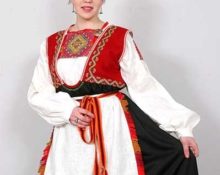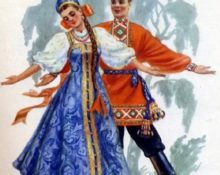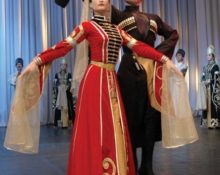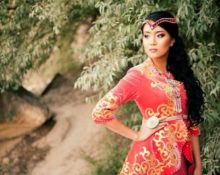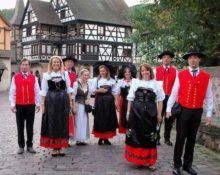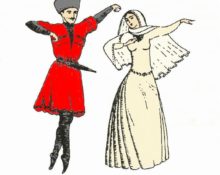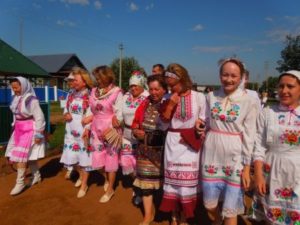 In the Volga-Vyatka region there is the autonomous republic of Mari El, inhabited by meadow, mountain and eastern groups of Mari. Their mentality, tolerance towards other peoples, gentle character are based on acceptance of everything in this world. This allowed them to preserve their faith and culture as the basis of authenticity and national color to this day. Costume is an integral part of the culture of this people.
In the Volga-Vyatka region there is the autonomous republic of Mari El, inhabited by meadow, mountain and eastern groups of Mari. Their mentality, tolerance towards other peoples, gentle character are based on acceptance of everything in this world. This allowed them to preserve their faith and culture as the basis of authenticity and national color to this day. Costume is an integral part of the culture of this people.
Types of Mari traditional costumes
Mari clothing was created for several occasions:
- everyday life;
- holiday;
- weddings
What details of the Mari costume exist?
Mari men's clothing in summer included the following elements:
 shirt - tuvyr - straight cut with sleeves sewn without armholes, end-to-end, and a central or side slit from the collar;
shirt - tuvyr - straight cut with sleeves sewn without armholes, end-to-end, and a central or side slit from the collar;- pants - yolash - made of homespun canvas with different step lengths - narrow for the inhabitants of the meadows and mountains or wide for the Eastern Mari;
- a belt with pendants - ÿshto - which performed several functions in a row. It served as the basis for attaching sheaths, tobacco pouches, flint, money wallet, amulets. Could be made of leather, hemp, silk, wool;
- summer caftan - shovyr - canvas, straight tunic-shaped cut;
- hat, cap - upsh, terkupsh - felted from wool.
In winter, other clothes were added to this set:
- Warm caftan - made from homemade cloth;
- Fur coat, sheepskin coat - koryk, uzga - sheepskin, straight cut or with a cut at the waist;
- The hat is made of sheep wool.
Styles, materials, colors, patterns for sewing
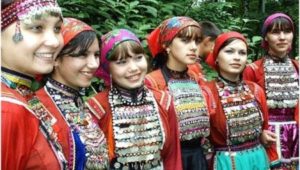 The national costume of the Mari people is white with red embroidered floral or geometric patterns. The embroidery was complemented with burgundy, black, blue, green, and brown colors. Clothes were made from canvas (vyner), the starting material for which was hemp or flax. It took women six months to weave it by hand and bleach it.
The national costume of the Mari people is white with red embroidered floral or geometric patterns. The embroidery was complemented with burgundy, black, blue, green, and brown colors. Clothes were made from canvas (vyner), the starting material for which was hemp or flax. It took women six months to weave it by hand and bleach it.
The work was very labor intensive. Over time, Mari women began to borrow snow-white cotton fabrics from Russian culture.
Winter clothes
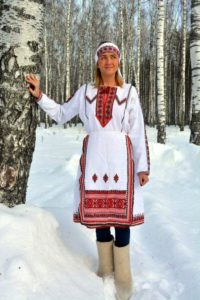 The winter clothes of the Mari were made of sheepskin: a fur coat was made from the skin, and the sheared wool of sheep was spun and woven from it into warm cloth (shrash) and half-cloth for caftans. The styles of clothing were quite simple: the shirt was cut out like a tunic with small collar and side slits. The sleeve was sewn in without an armhole, simply butt-joined to the main fabric. The styles of caftans were not distinguished by their complexity; they were straight-backed or with a cut-off waist.
The winter clothes of the Mari were made of sheepskin: a fur coat was made from the skin, and the sheared wool of sheep was spun and woven from it into warm cloth (shrash) and half-cloth for caftans. The styles of clothing were quite simple: the shirt was cut out like a tunic with small collar and side slits. The sleeve was sewn in without an armhole, simply butt-joined to the main fabric. The styles of caftans were not distinguished by their complexity; they were straight-backed or with a cut-off waist.
Women's fur coats were a little more difficult to cut. They had a seam on the shoulder and multi-gathering. It was convenient to work and relax in such clothes on holidays, because they did not restrict movement.
Important! According to the ancient beliefs of the people, it was necessary to protect all edges and openings with embroidery from the evil eye and diseases: collar, sleeve, cut, hem. The Mari really embroidered all the details of the costume very tightly. There are especially many ornaments in women's clothing.
Men's, women's, wedding suit
Men put on a shirt, trousers, belted themselves, and covered their heads with a hat or cap. If it was cool, the suit was complemented by a caftan, in winter - a warm caftan or fur coat.
Suits for women
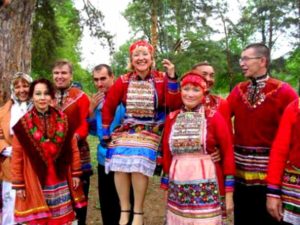 The women's costume also included a shirt, trousers, a caftan with a closed collar, and a belt with pendants. The clothing was complemented by an apron without a breast in the traditional version, and later - with a breast. This item of clothing was decorated with braid, lace, bead and thread embroidery. The color scheme of the ornament is red, brown, burgundy, purple, raspberry, lingonberry, black.
The women's costume also included a shirt, trousers, a caftan with a closed collar, and a belt with pendants. The clothing was complemented by an apron without a breast in the traditional version, and later - with a breast. This item of clothing was decorated with braid, lace, bead and thread embroidery. The color scheme of the ornament is red, brown, burgundy, purple, raspberry, lingonberry, black.
Elegant looks
Festive costumes were distinguished from everyday ones by more complex embroidery patterns and the presence of more coins on the belt, shirt, and headdress. The clothing fabrics were the best. For example, a caftan was sewn black for everyday life, and white for holidays, trimmed with black homespun canvas. Hats were felted from black wool for everyday life, and white wool was intended for rituals and holidays.
Suits for weddings
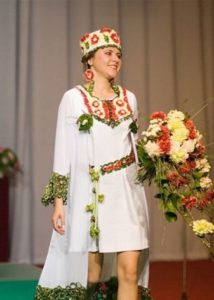 The bride's wedding costume was very beautiful, richly decorated with all kinds of embroidery. He could not do without a voluminous chest decoration made of coins and metal decoration. This decoration was created for the ceremony and then passed down in the family as an heirloom. His weight sometimes reached 35 kg. The obligatory wedding veil (vÿrgenchyk), sewn from three strips of white canvas and embroidered with traditional ornaments, served as the bride’s headdress..
The bride's wedding costume was very beautiful, richly decorated with all kinds of embroidery. He could not do without a voluminous chest decoration made of coins and metal decoration. This decoration was created for the ceremony and then passed down in the family as an heirloom. His weight sometimes reached 35 kg. The obligatory wedding veil (vÿrgenchyk), sewn from three strips of white canvas and embroidered with traditional ornaments, served as the bride’s headdress..
Important! The clothes from the wedding were never worn by the newlyweds. They saved it for funerals as a funeral attire.
Accessories and shoes for “Mari” clothing
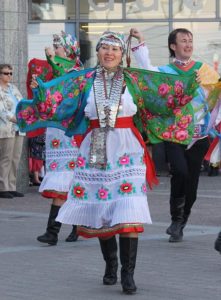 A special detail of the national dress is the women’s headdress, which carried basic information about its owner: social status, age, belonging to the Meadow, Mountain or Eastern Mari. A girl's headdress - a headband - could be made of leather or wool. It was especially carefully decorated with coins and beads, covering the entire outfit with them and complementing it with pendants made of the same materials.
A special detail of the national dress is the women’s headdress, which carried basic information about its owner: social status, age, belonging to the Meadow, Mountain or Eastern Mari. A girl's headdress - a headband - could be made of leather or wool. It was especially carefully decorated with coins and beads, covering the entire outfit with them and complementing it with pendants made of the same materials.
The women's headdress was quite complex and had the following types:
- Frame, pointed - shymaksh, shurka;
- Shovel-shaped - magpie;
- Soft towel – sharpan;
- Handkerchief.
Shurka, shymaksh and soroka are frame headdresses, the basis for which was birch bark. These headdresses and sharpans were also richly embroidered and decorated. Not only embroidery with braid was used. There could have been a lot of coins on the frame dresses. Sharpan was embroidered. In winter, women wore tall hats made of fox or beaver fur.
Men wore felted hats, caps, caps, and in winter - hats made of wool or sheepskin.
Seven-row bast sandals were put on the feet. On holidays, bast shoes were replaced with shoes or boots made of soft leather, and in cold weather they were insulated with felt boots.
Modern Mari costume
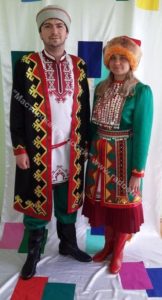 The Mari are very sensitive to their traditions. To this day, beliefs in pagan gods live here. And although only a few profess this faith, most of the population of the republic participates in symbolic religious rites. For national holidays and traditional Mari weddings, folk costumes are sewn and worn, which have undergone some changes, assimilated to modern conditions, but retained their main features.
The Mari are very sensitive to their traditions. To this day, beliefs in pagan gods live here. And although only a few profess this faith, most of the population of the republic participates in symbolic religious rites. For national holidays and traditional Mari weddings, folk costumes are sewn and worn, which have undergone some changes, assimilated to modern conditions, but retained their main features.


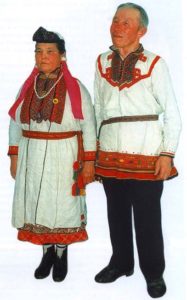 shirt - tuvyr - straight cut with sleeves sewn without armholes, end-to-end, and a central or side slit from the collar;
shirt - tuvyr - straight cut with sleeves sewn without armholes, end-to-end, and a central or side slit from the collar; 2
2